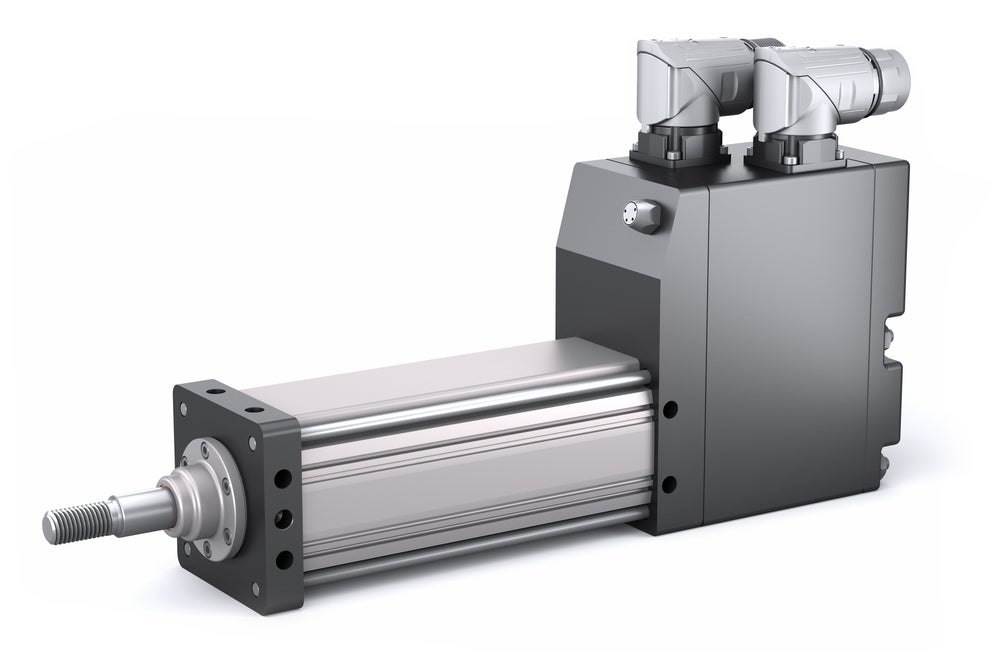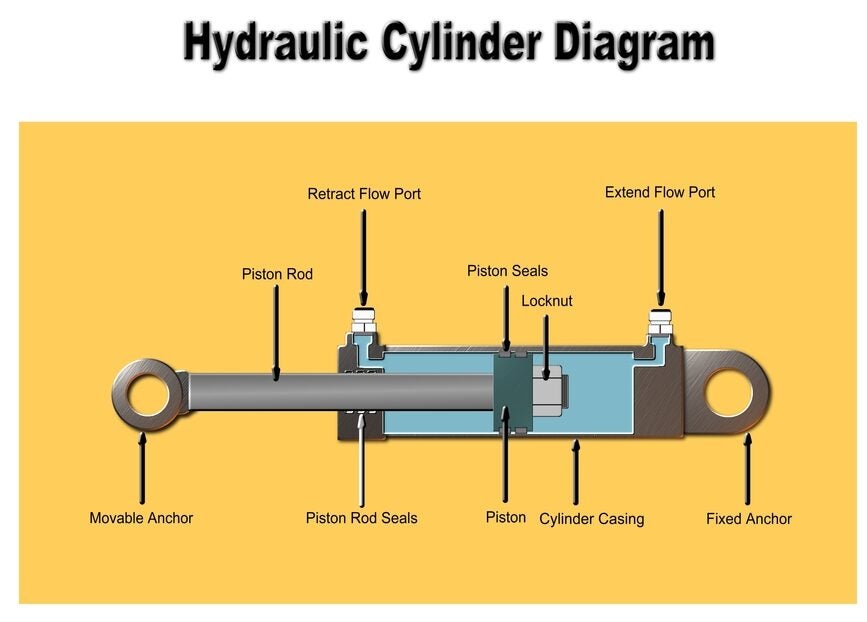
A linear electromechanical actuator servo
Actuators play an instrumental role in creating movement in various systems, converting energy into motion. There are a variety of actuator types each with their unique advantages. Among them, electro-mechanical, hydraulic, and pneumatic actuators are some of the most prominent. This article delves into their differences, benefits, and the industries and systems that favor each type.
|
ELECTRO-MECHANICAL VS. HYDRAULIC AND PNEUMATIC ACTUATORS |
||||
|
Feature/ Category |
Electro-Mechanical Actuators |
Hydraulic Actuators |
Pneumatic Actuators |
|
|
Components |
Electric motor (DC or AC), mechanical transmission system, controller |
Hydraulic cylinder, pump, fluid reservoir, control valves |
Cylinder, control valves, air source (compressor) |
|
|
Functionality |
Convert rotary motion to linear/other forms of motion |
Create mechanical motion through pressure applied to fluid |
Use compressed air to produce mechanical motion |
|
|
Benefits |
Precision, easy integration, clean operation |
High force in compact design, smooth motion, reliability |
Safety, speed, simplicity, cost-effective |
|
|
Challenges |
Less torque for same size, heat generation, vibration |
Potential for leaks, regular maintenance, many components |
Lower precision, need for clean dry air, less energy efficient |
|
|
Industries/ Systems |
Robotics, medical equipment, aerospace |
Construction, industrial automation, automotive |
Packaging, pharmaceutical, transport |
|
Electro-Mechanical Actuators
Electro-mechanical actuators consist of an electric motor (either DC or AC), and an associated mechanical transmission system and controller. The transmission system determines how the rotary motion of the motor gets converted into linear or other forms of motion, whereas the amount of force able to be produced is primarily a function of the motor’s capabilities and transmission system mechanics. Examples of some transmission systems include lead screws, ball screws, belts and pulleys, rack and pinions, and linear motors.
Benefits:
- Precision: These actuators provide highly precise and repeatable movement.
- Easy integration: They can be easily integrated into electronic control systems.
- Clean operation: No risk of fluid leaks, making them suitable for clean room applications
Industries/Systems:
- Robotics: For precision tasks like pick and place.
- Medical equipment: In devices like automated surgical tools.
- Aerospace: For flap and landing gear adjustments.

Hydraulic Actuators
Hydraulic actuators are composed of a hydraulic cylinder, a pump, fluid reservoir, and control valves. They can create create mechanical power through linear, rotary or socillatory motion. These actuators primarily function based on the fact that pressure applied to a confined fluid is transmitted throughout the fluid equally in all directions. Some challenges of note are the potential for leaks, requirement of regular maintenance for monitoring fluid levels, selas, and the large number of components.
Benefits:
- High force in compact design: They can produce a significant amount of force and torque while in a relatively small package.
- Smooth motion: Fluid dynamics allows for smoother motion compared to other systems.
- Reliability: Long-standing history of reliability in various applications.
Industries/Systems:
- Construction equipment: In machinery like excavators and bulldozers.
- Industrial automation: For heavy load-lifting tasks.
- Automotive: Brake and suspension systems.
Pneumatic Actuators
Pneumatic actuators are driven by compressed air and consist of a cylinder, control valves, and an air source (compressor). Pneumatic actuators utilize compressed air to produce mechanical motion. Unlike hydraulic actuators, which rely on incompressible fluids, pneumatic actuators use air, which is compressible. They usually suffer from lower precision compared to hydraulic systems, and require clean dry air for internal corrosion prevention. Furthermore, they can be less energy efficient compared to other actuation methods.
Benefits:
- Safety: Compressed air is non-flammable and poses fewer risks than hydraulic fluids.
- Speed: Pneumatics can achieve faster actuation speeds compared to some other systems.
- Simplicity: Pneumatics often have simpler designs compared to hydraulics, allowing for easier maintenance and troubleshooting.
- Cost-effective: Often cheaper to install and maintain than hydraulic systems.
Industries/Systems:
- Packaging: In automated product handling systems.
- Pharmaceutical: In drug dispensing and production systems.
- Transportation: For adjusting seats, doors, and other components
Choosing Electro-Mechanical vs. Hydraulic and Pneumatic Actuators
Electro-mechanical (EM) actuators, have precise control and easier integration into electronic systems. They shine in scenarios where granularity of control, environmental considerations, and integration with other digital systems are critical. They are often the go-to choice for industries that prioritize precision, cleanliness, and repeatability. Since they have a direct drive nature, there’s no risk of fluid leaks, making them apt for clean rooms, medical applications, or any environment where cleanliness is a necessity.
Hydraulic actuators win in terms of raw force. They have the unique ability of generating immense power from a relatively compact form factor. This makes them the top choice for heavy machinery, construction, and other high-load applications where sheer force and robustness are required. Additionally, their fluid-driven nature allows for smoother motion, which can be crucial in specific settings. However, potential leaks and the environmental considerations of hydraulic fluids can be limiting factors.
Pneumatic actuators offer an overall balance of speed, safety, and cost-effectiveness. The use of air as a driving force brings about a unique set of advantages: rapid actuation, inherent safety due to the non-flammable nature of air, and often a lower total cost of ownership due to simpler designs and fewer maintenance needs. However, their reliance on compressed air systems can limit their efficiency, and their precision might not match that of EM actuators. They fit perfectly in applications where speed and safety are crucial, and where the potential precision trade-offs are acceptable.
Having delved deep into the nuances of Electro-Mechanical, Hydraulic, and Pneumatic Actuators, it’s evident that the intricacies of design, application, and integration are vast. To streamline your design process and ensure optimal component choices, it’s vital to have reliable and comprehensive resources at your fingertips.
If you’re looking for CAD models for common components for your designs involving electro-mechanical, hydraulic, or pneumatic actuators, Ultra Librarian helps by compiling all your sourcing and CAD information in one place.
Working with Ultra Librarian sets up your team for success to ensure streamlined and error-free design, production, and sourcing. Register today for free.








